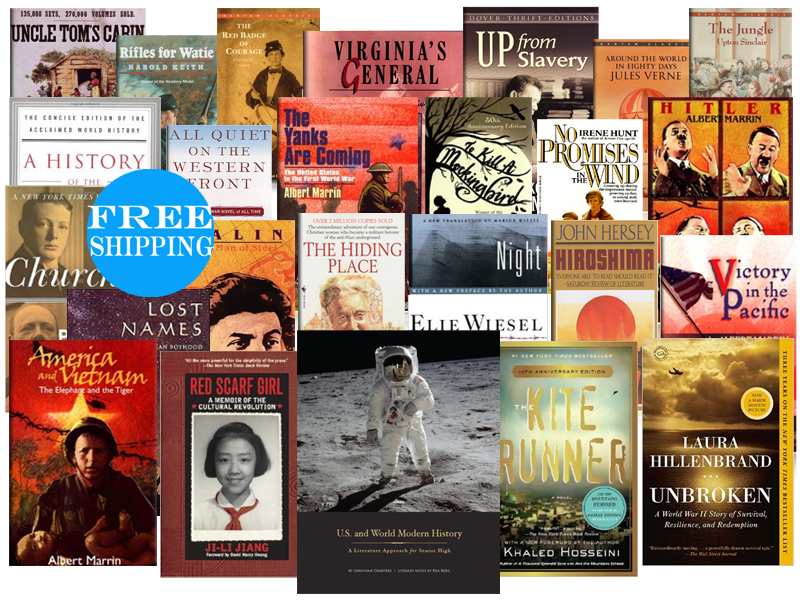U.S. and world history are combined in this upper-level course that covers the time period from the 1850s to the 2000s. The Modern U.S. and World History guide coordinates reading from real books while it also provides background reading material plus assignments and activities. This one-year course, written for students in their junior and senior years of high school, provides sufficient work for credits in both history and language arts.
Study is divided into five units:
- Antebellum and the Civil War
- Reconstruction, the Industrial Revolution, and the Turn of the Century
- The First World War, The Depression, and Segregation
- Building towards War, the Second World War, and the Atomic Age
- The Struggle for Freedom in the Twentieth and Twenty-First Centuries
U.S. and world history is covered through real books, with Martin Gilbert’s A History of the Twentieth Century serving as a spine. Chapters of Gilbert’s book are used alongside other books or on their own to ensure that students have sufficient coverage of the primary historical events to understand the context of the other books.
Other books used in the course are Uncle Tom’s Cabin, Rifles for Watie, The Red Badge of Courage, Virginia’s General: Robert E. Lee and the Civil War, Up From Slavery, Around the World in Eighty Days, The Jungle, All Quiet on the Western Front, Stalin: Russia’s Man of Steel, The Yanks Are Coming, No Promises in the Wind, To Kill A Mockingbird, Hitler, Churchill, The Hiding Place, Night, Unbroken, Victory in the Pacific, Hiroshima, Lost Names: Scenes from a Korean Boyhood, America and Vietnam: The Elephant and the Tiger, Red Scarf Girl: A Memoir of the Cultural Revolution, and The Kite Runner.
There are 124 lessons. Each lesson might be completed in one day, although some might take extra time. Daily lessons often begin with a list of vocabulary words that students will record and define. Vocabulary words will be encountered in the day’s reading assignments, so they vary according to the difficulty of the vocabulary in each book.
Each lesson assigns a number of chapters or pages to read, generally from one book, but sometimes also from A History of the Twentieth Century. Assignments are accompanied by a series of Socratic questions. Some comprehension questions are included, but they are used to build toward deeper questions and ideas rather than simple recall of information. Literary analysis questions are also included for six of the books. Internet links are included for students to do additional research and reading, sometimes from primary sources. Sometimes, there are links to videos.
Lessons sometimes direct students to write answers in a notebook, but most will be used for discussion. At the conclusion of most of the books, students are given an assignment for a five-paragraph essay. Sometimes other activities suggestions are given, activities such as creating a cartoon strip or creating and presenting a short dramatic performance. The last 50 pages of the 150-page guide are your answer key plus a six-page glossary of the vocabulary words encountered in the required books. The answer key will help parents and teachers with key ideas and suggested responses, but since the questions are Socratic, students might lead the discussion in different directions. Consequently, parents or teachers really should read the books to be able to carry on conversations. While students could try to write out answers rather than discussing them, I think that would discourage the kind of thoughtful analysis and even “rethinking” that more easily can occur within a discussion. Parents and teachers guiding a discussion can probe student answers to help them explain more fully, or they might challenge students’ answers with additional questions.
Since the required reading for students is so substantial, it might be difficult for parents to stay apace with the reading. If students are capable and responsible, parents might be able to skip the reading and take more of a listening role as students explain their responses and help parents understand the key ideas. The answer key might be sufficient to support this approach.
The tasks involved with the vocabulary words, notebook assignments, and essay assignments, coupled with the reading and literary analysis, provide plenty of work to satisfy requirements for a full credit in language arts.
The course does a great job of spanning various world cultures with books that will truly give students insight into unfamiliar worlds. While history coverage doesn’t include all of the details of a typical history textbook, the quality and breadth of coverage is probably better.
Lessons frequently talk about character qualities and once in a while use biblical allusions, but this is not a specifically Christian course. The book The Hiding Place does have a theme about reliance on God, but it is primarily a story of rescuers during World War II. Because of the Socratic design of the questions, the course should be suitable for those from various faith perspectives—it leaves room for parents or teachers to discuss questions from different points of view.
Economics-related questions have a very slight slant towards a free-market/limited-government point of view, but those looking to reinforce such a viewpoint might want to use some of the additional recommended books. Those optional, additional books and videos that touch on history, economics, and culture are described on pages 93 to 98.
You can purchase the guide by itself if you want to use books you already own or will buy or borrow individually. However, Beautiful Feet Books sells a complete package with all of the required resources.
Note: This book is not just a revision of the previous A Literature Approach to U.S. and World History, but is an entirely new book.









